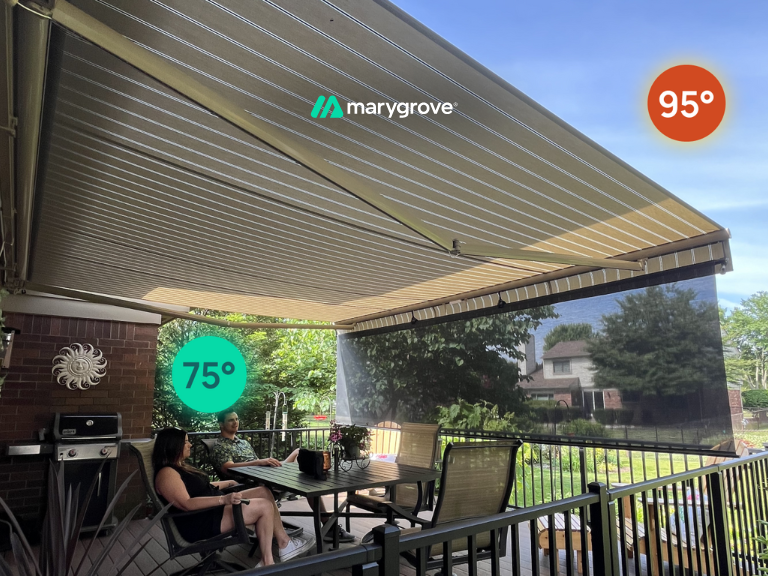Awnings reduce heat by blocking up to 77% of solar radiation before it hits your windows, patios, and exterior walls, helping cool indoor spaces and outdoor zones without overloading your AC.
How Awnings Reduce Heat: Quick Essentials
Heat gain starts outside, and that’s exactly where awnings go to work. Installed over south- and west-facing windows, they stop sunlight before it penetrates your home, easing the strain on cooling systems and lowering energy costs.
- Block 65–77% of solar heat at key windows and glass doors
- Reduce overall indoor temperature, not just one room
- Protect patios, decks, and exterior walls from radiant heat
- Defend interiors from UV damage to furniture and floors
- Work even better with fans, UV-reflective flooring, and side screens
- Smart awnings adapt to weather, voice commands, and wind speeds
- High-quality fabrics prevent mildew, trap less heat, and stay cooler to the touch
Whether you’re chasing cooler rooms, lower bills, or just a shaded space for your pets or kids, awnings are one of the most effective passive cooling solutions available today.
And if you’re thinking beyond shade, toward comfort, control, and real curb appeal, what comes next might just surprise you.
The Surprising Science Behind Shade: How Awnings Actually Cool Your Space

Awnings offer more than just visual appeal, they actively block heat before it enters your home, helping to keep both indoor and outdoor areas cooler without over-relying on air conditioning.
To understand their impact, it helps to look at how heat enters your home and how awnings intercept it at the source.
- Sunlight is the primary driver of indoor heat gain, especially through south- and west-facing windows that absorb the harshest afternoon rays. This solar exposure can spike indoor temperatures and push HVAC systems to their limits.
- Awnings can block up to 65–77% of solar radiation when properly positioned. By shading windows externally, they stop much of the sun’s heat before it even hits the glass, an approach far more effective than blinds or curtains alone.
- Their cooling effect extends beyond one room. Reducing solar gain at multiple points helps maintain a more balanced temperature across the home, easing the overall cooling load.
- They also protect more than windows. Awnings installed over patios, decks, or exterior walls prevent heat from radiating inward, keeping both the building and surrounding outdoor areas more comfortable.
This layered protection makes awnings one of the most effective passive cooling tools available.

But not all awning installations deliver the same results. To truly maximize their cooling power, it’s all about where you place them, and what areas need it most.
Where Awnings Work Best: Targeting Heat Before It Reaches Your Home

Awnings aren’t just decorative, they’re strategic tools for heat control. When installed in the right locations, they can transform how a home feels inside and out.
From sun-exposed patios to overheated living rooms, smart placement can make all the difference.
1. Why South- and West-Facing Installations Make the Biggest Difference
Homes with large south- and west-facing windows or patio doors often struggle with afternoon overheating.
These sides receive the most intense sun, especially in late afternoon when temperatures peak.
Installing awnings on these exposures can drastically cut down solar gain, making adjacent indoor rooms significantly more comfortable.
2. Creating Safer, Cooler Spaces for Kids, Pets, and High-Traffic Areas
Large glass sliders are notorious heat traps.
Adding an awning above them helps deflect sunlight, keeping the threshold, and the room beyond, cooler.
This is especially useful in family homes where young kids play near the floor, or where pets love basking by the door.
Shaded areas make it safer and more comfortable for everyone, extending the time spent indoors without blasting the air conditioning.
3. Protecting Interior Surfaces from UV Damage and Heat Exposure
Sunlight doesn’t just warm a space, it slowly degrades it. UV exposure can fade hardwood floors, discolor area rugs, and cause furniture to lose its vibrancy.
Awnings reduce this damage by acting as a barrier against direct rays, especially in sun-heavy entry points like bay windows or French doors.
The result? Cooler rooms and longer-lasting interior finishes.
Of course, even the best placement can only go so far if the materials aren’t up to the task. For real heat control, what your awning is made of matters just as much as where it goes.
It’s Not Just Fabric, It’s Heat Control: Why Material Choice Matters

Not all awnings are created equal, and fabric selection plays a huge role in how well an awning performs in hot weather.
Beyond color and pattern, the weave, weight, and composition of the material can mean the difference between a slightly cooler patio and a truly comfortable outdoor retreat.
1. How Fabric Weave and Weight Influence Heat Reflection
Tightly woven fabrics act like shields against solar radiation. The denser the weave, the more sunlight it reflects before it ever reaches your windows or walls.
Heavier fabrics also tend to perform better at blocking heat, especially when paired with opaque coatings or layers that boost their sun-deflecting properties.
2. Why Synthetic Materials Outperform Natural Blends
Synthetic options like polyester or acrylic tend to resist moisture and reflect heat more efficiently than natural blends like cotton-polyester.
These materials are engineered to stand up to harsh sun and humidity, maintaining their cooling performance over time without stretching, fading, or absorbing excess water.
3. Light vs. Dark Colors: A Balancing Act
When it comes to color, lighter shades naturally reflect more sunlight, keeping surfaces underneath cooler. Darker tones absorb more heat, which may be desirable in cooler climates or shaded areas.
While darker fabrics might hide dirt better, lighter ones help reduce thermal buildup, especially in peak summer months.
4. Breathability and Mildew Resistance in Humid Climates
In moisture-prone regions, fabric breathability is key.
Materials that allow airflow beneath the canopy prevent heat from getting trapped, which improves comfort and reduces mold risk.
Look for moisture-resistant, mildew-resistant fabrics that don’t retain dampness, especially if the awning is left extended after summer storms.
Once you’ve locked in the right material, the next step is choosing a style that fits your lifestyle. From fixed setups to fully automated systems, today’s awnings are as smart as they are effective.
Fixed, Retractable, or Smart-Controlled: Matching Awnings to Your Lifestyle

Choosing the right awning isn’t just about size and style, it’s about how you live.
Whether you’re looking for something hands-off or high-tech, there’s a shade solution that fits your routine, your climate, and your comfort preferences.
1. Fixed Awnings: Reliable, Low-Maintenance Shade
Fixed awnings are great for those who want year-round protection without the need for adjustments.
They’re cost-effective and built to last, making them ideal for permanent shade over windows, doors, or entryways.
However, because they stay in place, they can block winter sun, something to consider if you’re in a cooler region where natural warmth is welcome during colder months.
2. Retractable Awnings: Seasonal Control on Demand
Retractable awnings offer more flexibility, allowing you to extend or retract the canopy based on weather, time of day, or personal preference.
This style is especially useful in mixed climates, where spring and fall sun may be pleasant but summer heat requires extra coverage.
Hand-crank versions are budget-friendly, while motorized models provide convenience with the push of a button.
3. Smart Awnings: Shade That Thinks Ahead
For those who prefer a seamless, connected experience, smart-controlled awnings bring real-time adaptability into the equation.
Voice- and app-enabled models let you control your awning from anywhere, whether you’re at the grill, in the kitchen, or out running errands.
Some systems even integrate with home automation platforms, offering scheduled extensions or sun-tracking capabilities.
4. Built-In Wind Sensors for Peace of Mind
One standout feature in modern systems is the addition of wind sensors.
These devices detect high wind speeds and automatically retract the awning to prevent damage, no more rushing outside during a sudden storm.
It’s a simple safeguard that protects your investment and eliminates one of the most common worries homeowners have about large retractable setups.
Once you’ve chosen the right awning setup, there are even more ways to boost its effectiveness. With a few simple additions, you can turn basic shade into full-spectrum heat defense.
5 Shade-Stacking Ideas That Supercharge Heat Reduction

Awnings do the heavy lifting when it comes to cooling, but pairing them with the right additions can elevate comfort even more.
These smart upgrades help you beat the heat from every angle.
- Solar or Blackout Side Screens: Block harsh low-angle sun from the sides while maintaining airflow. Great for morning or evening glare.
- Ceiling Fans Under Awnings: Keep air moving and reduce that heavy, stagnant feeling on hot days. Fans enhance evaporative cooling and make shaded spaces feel breezier.
- UV-Reflective Rugs or Decking: Swap dark decking or hot tile for UV-resistant outdoor rugs or coated materials. This keeps the surface cool enough for bare feet and pets.
- Deciduous Trees Nearby: Trees with seasonal foliage add natural shade in summer but let the sun back in during colder months. A perfect pairing with retractable awnings.
- Light or Metallic-Finish Furniture: Outdoor furniture absorbs a surprising amount of heat. Reflective or lighter materials stay cooler to the touch under shade.
- Bonus – Privacy Drop Screens: Retractable side panels boost privacy, cut down on radiant heat, and protect against late-day sun without sealing off the space entirely.
Stacked together, these strategies turn any awning-covered area into a full-fledged cooling zone.
When combined with the right elements, an awning becomes more than a shade solution—it becomes the foundation of a truly livable outdoor space. Layer smart, and you cool smarter.
Conclusive Thoughts — Making the Smart Shade Choice for Your Home
When it comes to blocking heat and boosting comfort, awnings often outperform DIY shade sails and pergolas.
Unlike fixed structures, retractable awnings adapt with the seasons and your schedule, especially when enhanced with smart features like app control, voice activation, or automatic wind sensors.
This blend of function and ease adds a quiet touch of luxury to everyday life. More and more homeowners are pairing awnings with eco-conscious upgrades like solar panels and low-E windows, creating smarter, more efficient homes from the outside in.
If you’re looking for a shade solution that balances comfort, control, and curb appeal, an awning could be your smartest investment yet.
Ready to feel the difference? Schedule a free awning consultation appointment today!
Explore how a professionally installed, thoughtfully placed awning can help you reclaim your space from the heat, while enhancing the way your home looks and lives.


